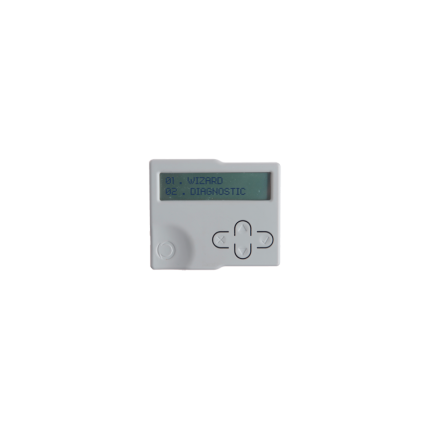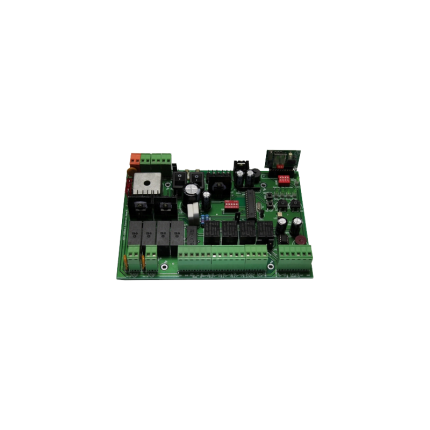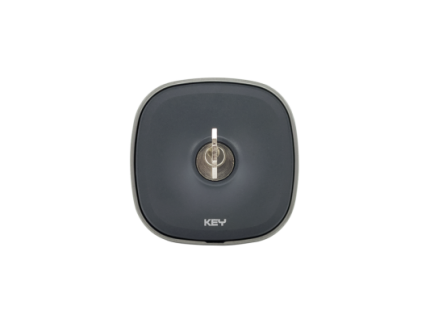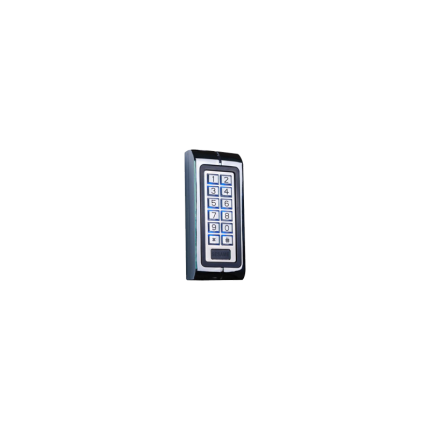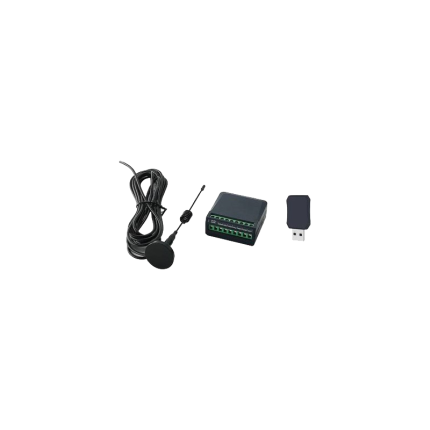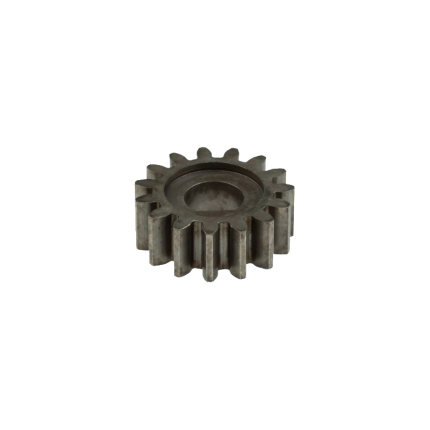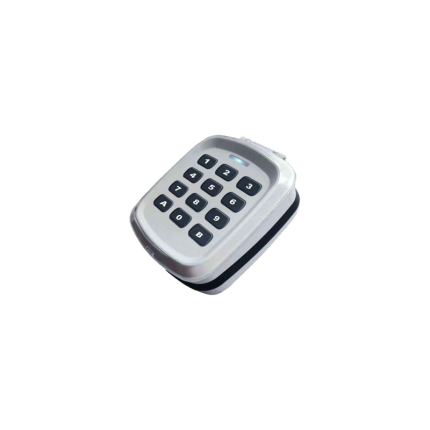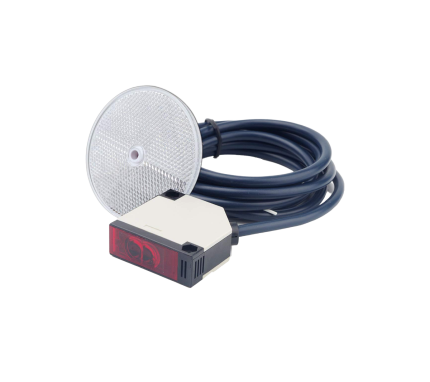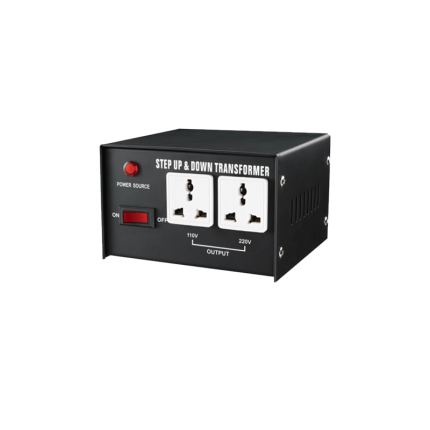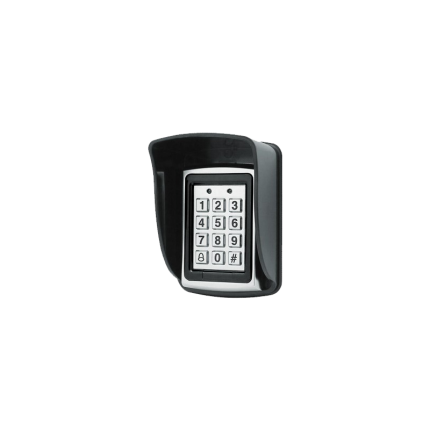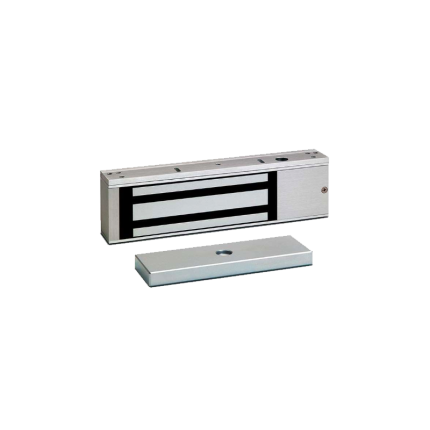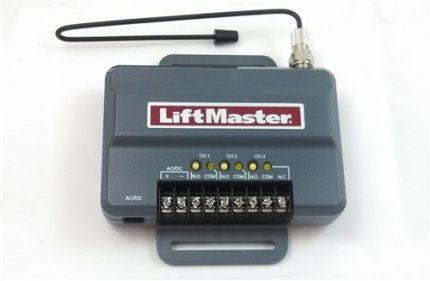Shop
Programmer module -Key Automation 900DYL
Ship or pick up from our office.
PRODUCT SHEET PDFProgrammer module -Key Automation 900DYL
*REMOTE LCD CONTROLLER *Display module cable length: 120 cmThe Key Automation 900DYL is a programming module used to configure and customize the settings of Key Automation 14A control units, commonly found in sliding and swing gate openers.
It allows installers to adjust parameters and settings of the gate automation system, such as torque, tension, and auto-close features. It also facilitates the addition of new remote controls.
Here's a more detailed breakdown:
-
Programming Module:The 900DYL is a specific programmer designed for the Key Automation 14A control board.
-
Customization:It enables adjustments to various settings of the gate opener, including speed, force, and other operational parameters.
-
Remote Control Integration:The programmer allows installers to add and configure new remote controls for the gate opener.
-
Emergency Release:In case of a power failure, the 900DYL, in conjunction with the gate opener, provides an emergency release mechanism.
-
Applications:It's used with both sliding and swing gate operators, and it's compatible with the 14A control unit.
Swing gate operator control board SWRG110
Ship or pick up from our office.
Swing gate operator control board SWRG110
The SWRG110 is a universal swing gate operator control board designed to manage the operation of AC (Alternating Current) powered swing gate motors. It's essentially the "brain" of a swing gate automation system, responsible for controlling the gate's movement, safety features, and integration with various accessories. It's often marketed as a replacement or upgrade board due to its broad compatibility with different AC swing gate openers, particularly those operating at 110V or 220V. Key Features and Functionality The SWRG110, as a universal control board, typically offers a range of features for efficient and safe gate operation:- Motor Control: It manages the power supply and direction of one or two AC gate motors, allowing for opening and closing cycles. It can be used for both single and double swing gates.
- Soft Start/Stop: This feature ensures a smooth and gradual acceleration and deceleration of the gate, reducing wear and tear on the motor and mechanical components, and providing quieter operation.
- Obstacle Detection: A crucial safety feature, obstacle detection allows the gate to stop or reverse if it encounters an obstruction during its movement, preventing damage to the gate, vehicle, or injury to people or pets. This is often achieved through current sensing or external safety sensors like photocells.
- Automatic Close: This function allows the gate to automatically close after a set period of time, enhancing security and convenience.
- Limit Switches: The board interfaces with limit switches (often magnetic or mechanical) to define the full open and full closed positions of the gate, ensuring precise stopping.
- Remote Control Learning: It typically has a learning function to pair with wireless remote controls, allowing users to open and close the gate from a distance.
- Accessory Interfaces: The SWRG110 provides terminals for connecting various gate accessories, such as:
- Photocells/Infrared Sensors: For enhanced safety and obstacle detection.
- Warning Lights: To signal gate movement.
- Keypads/Intercoms: For controlled access.
- GSM Modules/Phone APP integration: Some versions may offer connectivity for remote control via smartphone.
- Wall Buttons: For manual operation from inside the property.
- Exit Wands/Vehicle Sensors: To automatically open the gate for exiting vehicles.
- Adjustable Settings: Many control boards like the SWRG110 offer adjustable parameters, such as:
- Motor power/force (especially for obstacle detection sensitivity).
- Slowdown speed.
- Automatic close timer.
- Working time for each motor.
- Diagnostic Display: Some models include an LED or LCD display for easier setup, programming, and troubleshooting of errors.
- AC Powered Motors: Specifically, 110V or 220V AC swing gate motors. It's not compatible with DC (12V or 24V) motors.
- Various Gate Opener Models: It can replace control boards in numerous existing swing gate openers, such as some ALEKO and Lockmaster models.
- Power Disconnection: Safely disconnecting power to the gate opener.
- Wiring: Connecting the motor, power supply, and accessories to the appropriate terminals on the SWRG110 board. Understanding terminal functions is crucial for correct wiring.
- Programming: Learning remote controls and adjusting settings (e.g., limit switch calibration, auto-close time) according to the specific gate and desired operation.
Key selector -Key Automation EGS101
Ship or pick up from our office.
Key selector -Key Automation EGS101
The EGS101 is a gate/door opener key selector manufactured by KeyAutomation. It's designed for high-security residential and commercial properties and allows manual operation of automatic gates or doors using a physical key, according to KeyAutomation.A key selector for gates is a physical switch, often a key-operated switch, that allows manual operation of an automatic gate or door.
It's a security feature and backup system for situations where automated control is unavailable or undesirable.
TECHNICAL FEATURES
| Voltage | Vdc | Max 48 |
| Degree of protection | IP | 55 |
| Dimensions (L - D - H) | mm | 79 - 23 - 79 |
| Item | kg | 0,335 |
| Minimum operating temperature | °C | -20 |
| Max operating temperature | °C | +55 |
A key selector for door openers is a switch that allows you to operate an automated door or gate using a physical key, often as an alternative or backup to other access methods like remote controls or keypads.
These switches are commonly used in situations where you need to control access to a gate, garage door, or other automated barrier.
-
Function:Key selectors are designed to activate the door or gate opener's motor by completing an electrical circuit when the key is turned.
-
Mechanism:They typically involve a key cylinder that, when turned, activates a set of electrical contacts.
-
Applications:They are used in various settings, including residential, commercial, and industrial applications, such as garage doors, gates, and automatic doors.
-
Features:Some key selectors offer multiple functions, like automatic, lock, exit, and hold-open modes.
-
Types:They can be found as jamb key switches for garage doors or as more sophisticated selector switches for automatic doors with multiple functions.
Keypad – K180SC103
Ship or pick up from our office.
Keypad - K180SC103
*EM/ID card/tag reader *Shock resistance *Anti-vandal Metal shell *Backlight *1000 Users *DC 12 V *IP 67 *Doorbell *Rain Shield Cover included The Keypad - K180SC103 is an access control keypad typically used for security systems, gate openers, or door entry systems. 🔑 It's designed to allow access by entering a digital code. Here's what we know about it: Functionality:- Code-Based Access: The primary function is to grant access when a correct digital code is entered.
- Security System Integration: It's likely part of a larger access control system, where it sends signals to a control panel or hub to manage entry.
- Applications: Commonly found in residential or commercial settings for controlling gates, garage doors, and electronic door locks.
- Relay Output: It features a relay output with a maximum contact of 15A/120VAC & 10A/30VDC, offering two modes: toggle click and self-hold. This allows it to control various devices, including lights, automatic feeders, and water pumps.
- Weatherproof (IP44): This rating suggests it can withstand certain outdoor conditions, making it suitable for gate or outdoor door applications.
- Timer Function: In self-hold mode, you can set a timer to adjust the working time of the connected device.
- Dimensions: Approximately 24 × 18 × 12 cm.
- Weight: Around 0.8 kg.
USB Gate Operator Remote
USB Gate Operator Remote
A USB gate operator remote control is a device that allows you to open and close automatic gates or garage doors by plugging a USB dongle into your car's USB port and using it as a remote. USB Gate Operator Remote emits a sensing signal upon receiving a command from the USB port, which then triggers the gate opener to open or close the driveway gate. Here's a more detailed explanation: -How it works: USB Dongle: The device typically includes a small USB dongle that plugs into your car's USB port. Sensing Signal: When the USB is plugged in and the car is in the "on" mode, the dongle emits a sensing signal. Receiver: The signal is received by a unit connected to the driveway gate motor. Gate Motor Activation: The receiver then activates the gate motor, causing the driveway gate to open or close. -Key features: Dual Control Modes: Some models offer both automatic and manual modes, allowing you to operate the gate either by proximity sensing or by pressing a button on the USB dongle. Compact and Portable: The USB dongle is small and lightweight, making it easy to use and store in your car. Easy Installation: It's designed for simple plug-and-play functionality, requiring no complex setup. Replacement Accessory: It serves as a convenient replacement for traditional gate remote controls.Sliding gate operator gear
Ship or pick up from our office.
Sliding gate operator gear
A sliding gate operator gear refers to the toothed gear or rack and pinion system that facilitates the movement of a sliding gate.
This system typically consists of a toothed metal bar (the rack) attached to the gate and a motorized pinion gear that engages with the rack, causing the gate to slide open and closed.
Here's a more detailed explanation:
-
Rack:This is a toothed bar, usually made of steel or nylon-reinforced steel, mounted along the bottom of the sliding gate.
-
Pinion Gear:This gear is connected to the motor of the gate operator. When the motor rotates, the pinion gear engages with the rack's teeth, causing the gate to move.
-
Operation:The rotation of the pinion gear drives the gate along the track, either opening or closing it, depending on the direction of rotation.
-
Materials:While some racks are made of all-metal, nylon racks with a steel core are popular due to their lightweight nature, durability, and resistance to rust and wear.
Wireless Keypad Access Control KW125
Wireless Keypad Access Control KW125
*2 channels *LED Light *433 MHz *Rain coverWireless keypad access control systems KW125replace traditional keys with a digital PIN code entry for building access, eliminating the need for physical keys and enhancing security.
These systems often include features like remote management via smart devices, audit trails of access events, and integration with other security systems like intercoms.
Here's a more detailed breakdown:
Core Functionality:
-
Keyless Entry:Users enter a unique PIN code into a keypad to unlock a door or gate.
-
Wireless Communication:The wireless keypad access control KW125 communicates wirelessly with a receiver or controller, eliminating the need for extensive wiring.
-
Remote Management:Many systems allow administrators to manage access permissions, view audit trails, and adjust settings remotely via a smartphone app or computer.
-
Integration:Some systems can integrate with intercoms, surveillance cameras, and other security components for a more comprehensive solution.
Key Features for the wireless keypad access control KW125:
- PIN Codes: Users are assigned unique PIN codes for entry.
- Proximity Cards/Fobs: Some systems also support access via proximity cards or fobs for users who prefer that method.
- Audit Trails: The system can record and store data about who accessed the door, when, and how, providing a valuable security record.
- Weatherproof and Durable: Many outdoor keypads are designed to withstand harsh weather conditions and vandalism.
- Backlit Keypads: Backlit keypads make it easier to use the system in low-light conditions.
Types of Wireless Keypad Access Control:
- Stand-Alone Systems: These systems are self-contained and don't require connection to a central system.
- Integrated Systems: These systems are part of a larger access control or building management system.
- Wired and Wireless Hybrid: Some systems combine wired and wireless components for added flexibility.
Benefits:
- Enhanced Security: Eliminates the risk of lost or stolen keys.
- Increased Convenience: Users don't need to carry keys.
- Improved Auditability: Tracks access events for security monitoring.
- Remote Management: Allows for easy administration and control.
Power inverter 110 V to 220 V
Ship or pick up from our office.
Power inverter 110 V to 220 V
A power inverter 110V to 220V (also known as a step-up voltage converter) is an electronic device that transforms an input voltage of 110 volts (V) into an output voltage of 220V. This type of inverter is crucial for bridging the gap between different regional electrical standards. How It Works At its core, a 110V to 220V power inverter utilizes a transformer to achieve the voltage conversion. Here's a simplified explanation:- Input (DC to AC Conversion for Inverters): While the prompt asks about a "power inverter 110V to 220V," it's important to clarify that traditional inverters convert DC (Direct Current) from a battery (e.g., 12V, 24V, 48V) into AC (Alternating Current). If the input is already 110V AC, then the device is more accurately called a voltage converter or transformer, as it's stepping up AC to AC. However, some inverters are designed to take a DC input and produce 110V AC or 220V AC, or even both.
- Step-Up Transformation: For a 110V AC to 220V AC conversion, the device contains a transformer with primary and secondary coils. The 110V AC from the power source is fed into the primary coil. Through electromagnetic induction, this voltage is "stepped up" to 220V in the secondary coil, which then becomes the output.
- Waveform: Inverters and converters can produce different types of AC waveforms:
- Pure Sine Wave: This is the most desirable waveform, replicating the smooth, consistent power from a utility grid. It's ideal for sensitive electronics.
- Modified Sine Wave: This is a cruder approximation of a sine wave and is generally suitable for less sensitive appliances, but can cause issues or damage with certain delicate electronics.
- Power Capacity (Wattage): This indicates how much power the device can supply. Ensure it's sufficient to handle the total wattage of the appliances you intend to connect. Exceeding the inverter's capacity can lead to damage.
- Efficiency: A higher efficiency rating means less energy is wasted as heat during the conversion process, which is important for battery-powered setups.
- Safety Features: Look for features like overload protection, short-circuit protection, and surge protection to safeguard your appliances and the inverter itself.
- Frequency: Electrical grids operate at either 50 Hz or 60 Hz. Ensure the inverter's output frequency matches the requirements of your appliances. Some inverters can switch between frequencies.
- Portability: Some are designed for travel, while others are larger for industrial or home use.
- International Travel: They allow travelers from countries with 110V systems (like North America) to use their 220V appliances (like hair dryers, chargers) in countries with 220V outlets (common in Europe, Asia, and other regions).
- Using Imported Appliances: If you have an appliance designed for 220V (e.g., a European kitchen appliance) but your home has 110V outlets, a step-up converter enables you to use it.
- Industrial and Specialized Applications: In industries, they can be used for automation and control systems, telecommunications, and emergency power systems to ensure compatible power supply for various equipment.
- Renewable Energy Systems: In off-grid solar or wind power setups, inverters convert DC power from batteries into the required AC voltage (which could be 110V or 220V depending on the load).
- High-Power Appliances: Some larger appliances or specialized tools might require 220V power, even in regions where 110V is standard for most household items. A converter can provide the necessary voltage without extensive electrical rewiring.
Magnetic lock
Ship or pick up from our office.
Magnetic lock
*Capacity: 180 Kg *DC 12 V A magnetic lock, also known as an electromagnetic lock or maglock, is a locking device that uses the principles of electromagnetism to secure a door. Unlike traditional mechanical locks, it has no moving parts. How It Works A magnetic lock consists of two main components:- Electromagnet: This is typically mounted on the door frame. It contains a coil of wire wrapped around a ferromagnetic core.
- Armature Plate: This is a steel plate mounted on the door itself, designed to align with the electromagnet.
- High Security: Magnetic locks can provide a very strong holding force, making them difficult to force open. They are also virtually unpickable, as there are no keyholes or cylinders.
- Durability and Low Maintenance: With no moving parts, magnetic locks experience less wear and tear than traditional locks, leading to greater longevity and reduced maintenance needs.
- Quick Operation: They unlock instantly when power is cut, allowing for quick release, which is beneficial in high-traffic areas or emergencies.
- Remote Operation and Access Control Integration: Magnetic locks can be easily integrated into electronic access control systems, allowing for remote operation, key card/fob access, biometric scanning, and detailed access logging.
- Versatility: They can be installed on various door types, including glass, wood, and metal, and are suitable for both swinging and sliding doors.
- Ease of Installation: Compared to some other electric locks, maglocks can be relatively straightforward to install.
- Constant Power Requirement: Magnetic locks need a continuous power supply to remain locked. This means they are dependent on electricity, and a power outage will result in the door unlocking (fail-safe).
- Cost: While the initial cost of the lock itself might be comparable, the overall installation can be more expensive due to the need for electrical wiring, power supplies, and integration with other security systems.
- Additional Hardware for Safety: To comply with building codes and ensure safe egress, magnetic locks often require additional hardware such as push-to-exit buttons, motion sensors, or panic bars.
- Maintenance of Backup Systems: If battery backups are used to mitigate power outages, these batteries require regular checking and replacement.
Radio receiver – LiftMaster 850LM – 3 Channels
Ship or pick up from our office.
Radio receiver – LiftMaster 850LM – 3 Channels
Universal Radio Receiver LiftMaster 850LM is used for garage doors and driveway gate operators.
- Universal Radio Receiver Liftmaster 850LM is suitable for residential and commercial sliding gates and swing driveway gates.
- Security Encrypted Code For Extra Dependability.
- Manage Multiple Access Points With A Single LiftMaster Radio Receiver.
- 3 channels for control of 3 driveway gate openers.

